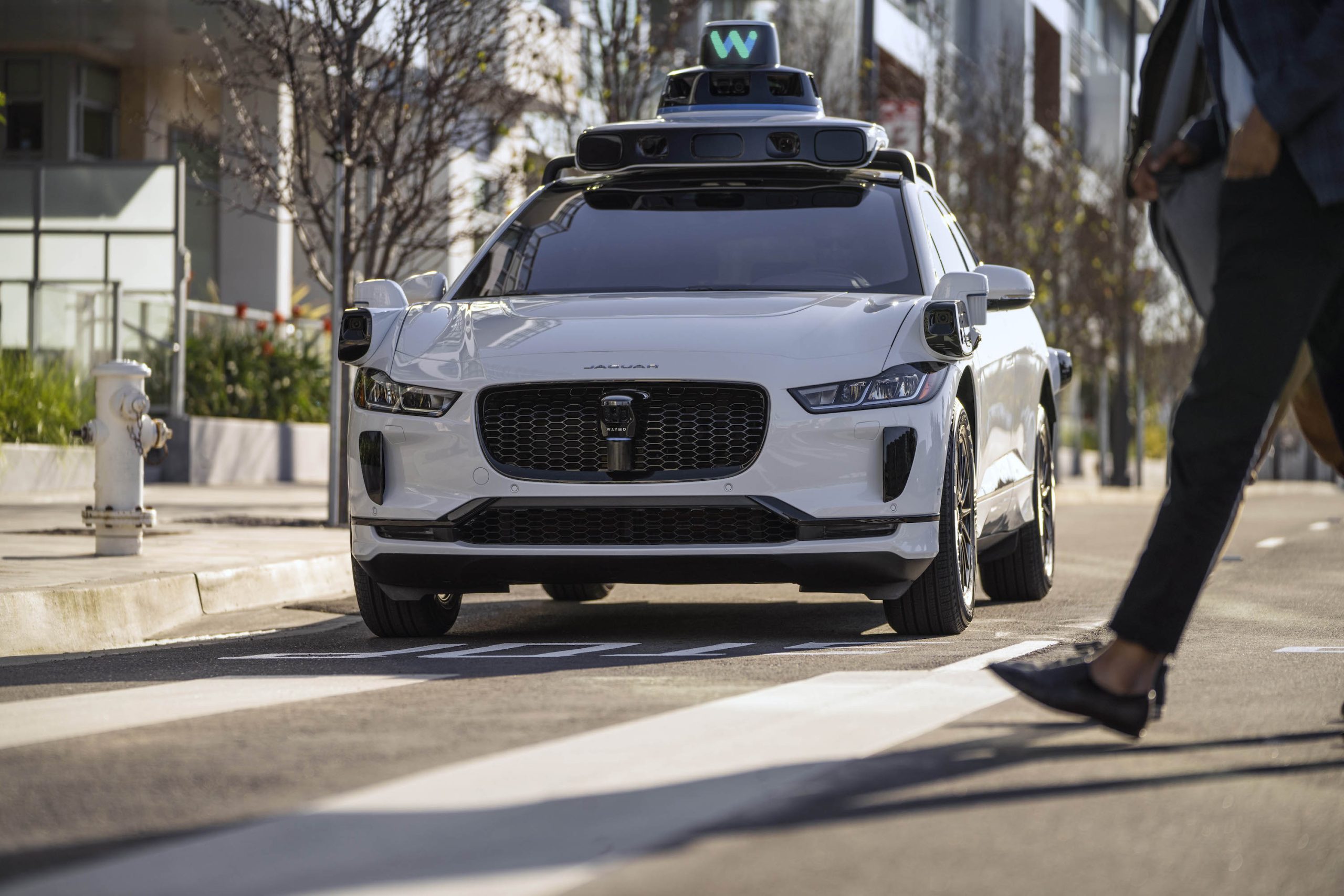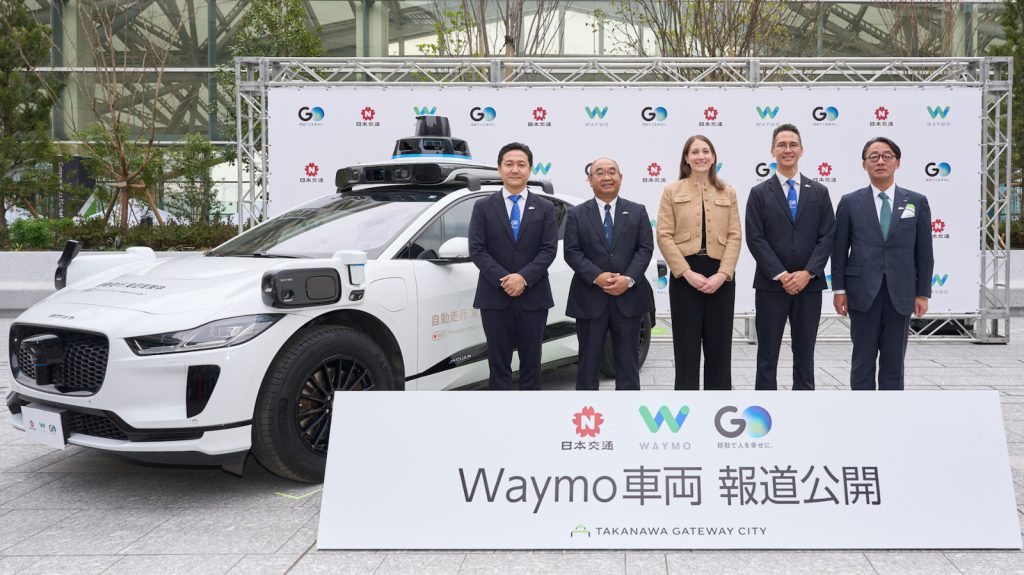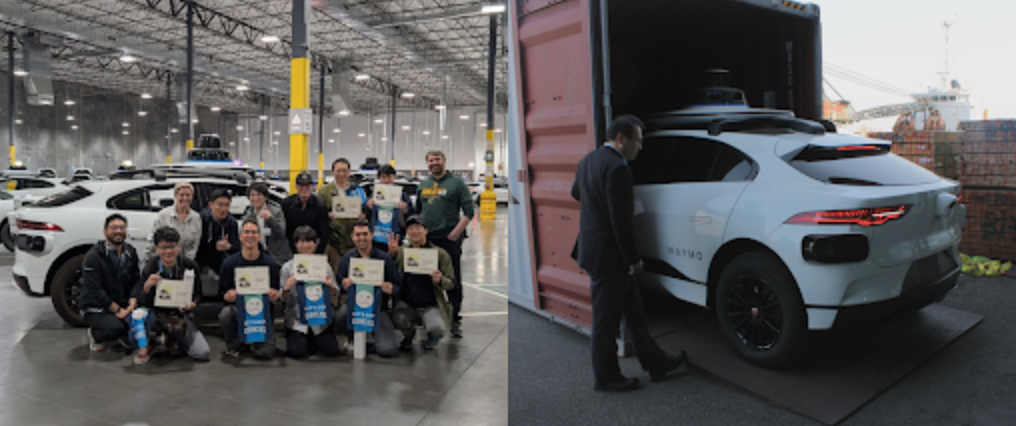News
Waymo kicks off initial tests in Japan with launch event
Waymo launches early tests in Japan, as Tesla and others look to roll out their own commercial robotaxi services.

Commercial robotaxi company Waymo held a launch event in Japan last week, as the company prepares to enter early manual testing on its first international roads.
After Waymo shared plans to start testing vehicles in Japan in December, the Google-owned firm detailed the launch event in a press release on Monday. The event featured officials from project partners GO, a taxi platform, and Nihon Kotsu, the largest taxi company in Tokyo, along with featuring one of the company’s camera-, lidar-, and radar-outfitted Jaguar I-Pace units, expected to begin manual testing around Tokyo in the weeks to come.
Ichiro Kawanabe, Board Director at Nihon Kotsu and Chairman at both GO and the Japan Taxi Association, said that Waymo’s U.S. operations “demonstrated significant safety benefits,” along with thanking the company for hosting the event at the newly developed Takanawa Gateway City complex.
“I took my first ride with Waymo in Phoenix a year and a half ago and was amazed that there was really no one in the driver’s seat,” the chairman said. “That was the moment I was convinced that autonomous driving technology could absolutely benefit Japan. It will help ensure mobility service in the future of Japan, with the growing aging population and labor shortage.”

Credit: Waymo

Credit: Waymo
This spring, Nihon Kotsu taxi operators will start driving Waymo vehicles across several Tokyo wards this spring, including Chiyoda, Chūō, Kōtō, Minato, Shibuya, Shinagawa, and Shinjuku. The tests will utilize 3D maps of the city, along with utilizing experienced drivers to generate data about traffic laws, patterns, and other road systems ahead of fully autonomous operation.
“After months of strong collaboration with Nihon Kotsu and GO, Waymo has reached a historic milestone— our first venture on international public roads,” said Nicole Gavel, Waymo Senior Director and Head of Business Development and Strategic Partnerships.
“Our partnership demonstrates how Waymo’s 15 years of operational expertise can adapt to new environments through strategic initiatives with industry leaders,” Gavel adds. “In Tokyo, we are abiding by the same steadfast principles that guide us in the U.S. — commitment to safety, dedication to earning trust in communities where we operate, and collaboration with local officials and community groups here in Tokyo.”
The news comes as Tesla, Amazon-owned firm Zoox, and still others are racing to enter the commercial robotaxi business throughout this year. It also comes amidst widespread speculation and debate about the emerging market, and as Tesla and Waymo both aim to begin operations internationally.
READ MORE ON WAYMO: Waymo study analyzes collisions with vulnerable road users
Tesla’s FSD in China, Mexico, commercial robotaxis still incoming
Waymo is already operating paid autonomous ride-hailing services around the U.S., and it said in December that it was giving more than 200,000 autonomous rides per week.
The company currently offers Waymo services in San Francisco and Los Angeles, California, Phoenix, Arizona, and, through a partnership with Uber, in Austin, Texas, where Tesla has a Gigafactory and plans to launch initial robotaxi services. The Alphabet-owned company is also aiming to launch services in Atlanta, Georgia and Miami, Florida this year, alongside its early tests in Tokyo.
Although Tesla doesn’t currently operate driverless ride-hailing in any capacity, individual owners in North America can purchase or subscribe to its Supervised Full Self-Driving (FSD) system, on which the company’s forthcoming robotaxi platform will be based. In October, the company unveiled the two-seat Cybercab vehicle, which has no steering wheel or pedals and will be used for the upcoming commercial robotaxi system.
Additionally, the company is aiming to launch its first unsupervised rides commercially in Austin in June, and it recently debuted Supervised FSD in China and Mexico, marking the company’s first international markets.
🎥: Our FULL first ride in the @Tesla Cybercab pic.twitter.com/6gR7OgKRCz
— TESLARATI (@Teslarati) October 11, 2024
Waymo vs. Tesla vs. the competition
While Tesla hasn’t quite gotten a commercial robotaxi service to market yet, Waymo, Amazon-owned company Zoox, and still many others have begun their own paid ride-hailing services or early tests. Meanwhile, Tesla’s approach to the technology is vastly different than that of Waymo and others, utilizing a camera-only, AI-trained neural network system, rather than 3D geomapping.
For one, the company can generate a larger pool of training data from real-time driving behavior of its individual owners, for instance as compared to Waymo’s use of a more-limited fleet of taxi drivers. Many argue that this, along with the cost-effectiveness of producing a system that’s built into every vehicle and utilizes only cameras, make the system more scalable than those of Waymo and others.
Still, some support the use of more than just camera systems and building in sensor redundancy as a way to maximize safety, especially as the technologies are still fairly new. Former Waymo CEO John Krafcik, who was a part of the company until 2021, criticized the FSD system in December for not including enough safety measures to support a realistic commercial robotaxi business, and he went on to call Tesla “a car company with a driver-assist system.”
“If a company were serious about building a safe and accessible robotaxi business, it would look nothing like what was shown,” Krafcik said during an interview. “The cost of a robust sensor set, including lidar, is trivial on a per-mile basis. Even more so for mapping. And the safety benefits measured in human harm reduction are real and verifiable.”
Waymo valued at over $45 billion following latest financing round: report

News
Tesla FSD Supervised wins MotorTrend’s Best Driver Assistance Award
The decision marks a notable reversal for the publication from prior years, with judges citing major real-world improvements that pushed Tesla’s latest FSD software ahead of every competing ADAS system.

Tesla’s Full Self-Driving (Supervised) system has been named the best driver-assistance technology on the market, earning top honors at the 2026 MotorTrend Best Tech Awards.
The decision marks a notable reversal for the publication from prior years, with judges citing major real-world improvements that pushed Tesla’s latest FSD software ahead of every competing ADAS system. And it wasn’t even close.
MotorTrend reverses course
MotorTrend awarded Tesla FSD (Supervised) its 2026 Best Tech Driver Assistance title after extensive testing of the latest v14 software. The publication acknowledged that it had previously criticized earlier versions of FSD for erratic behavior and near-miss incidents, ultimately favoring rivals such as GM’s Super Cruise in earlier evaluations.
According to MotorTrend, the newest iteration of FSD resolved many of those shortcomings. Testers said v14 showed far smoother behavior in complex urban scenarios, including unprotected left turns, traffic circles, emergency vehicles, and dense city streets. While the system still requires constant driver supervision, judges concluded that no other advanced driver-assistance system currently matches its breadth of capability.
Unlike rival systems that rely on combinations of cameras, radar, lidar, and mapped highways, Tesla’s FSD operates using a camera-only approach and is capable of driving on city streets, rural roads, and freeways. MotorTrend stated that pure utility, the ability to handle nearly all road types, ultimately separated FSD from competitors like Ford BlueCruise, GM Super Cruise, and BMW’s Highway Assistant.
High cost and high capability
MotorTrend also addressed FSD’s pricing, which remains significantly higher than rival systems. Tesla currently charges $8,000 for a one-time purchase or $99 per month for a subscription, compared with far lower upfront and subscription costs from other automakers. The publication noted that the premium is justified given FSD’s unmatched scope and continuous software evolution.
Safety remained a central focus of the evaluation. While testers reported collision-free operation over thousands of miles, they noted ongoing concerns around FSD’s configurable driving modes, including options that allow aggressive driving and speeds beyond posted limits. MotorTrend emphasized that, like all Level 2 systems, FSD still depends on a fully attentive human driver at all times.
Despite those caveats, the publication concluded that Tesla’s rapid software progress fundamentally reshaped the competitive landscape. For drivers seeking the most capable hands-on driver-assistance system available today, MotorTrend concluded Tesla FSD (Supervised) now stands alone at the top.
News
Elon Musk’s Grokipedia surges to 5.6M articles, almost 79% of English Wikipedia
The explosive growth marks a major milestone for the AI-powered online encyclopedia, which was launched by Elon Musk’s xAI just months ago.

Elon Musk’s Grokipedia has grown to an impressive 5,615,201 articles as of today, closing in on 79% of the English Wikipedia’s current total of 7,119,376 articles.
The explosive growth marks a major milestone for the AI-powered online encyclopedia, which was launched by Elon Musk’s xAI just months ago. Needless to say, it would only be a matter of time before Grokipedia exceeds English Wikipedia in sheer volume.
Grokipedia’s rapid growth
xAI’s vision for Grokipedia emphasizes neutrality, while Grok’s reasoning capabilities allow for fast drafting and fact-checking. When Elon Musk announced the initiative in late September 2025, he noted that Grokipedia would be an improvement to Wikipedia because it would be designed to avoid bias.
At the time, Musk noted that Grokipedia “is a necessary step towards the xAI goal of understanding the Universe.”
Grokipedia was launched in late October, and while xAI was careful to list it only as Version 0.1 at the time, the online encyclopedia immediately earned praise. Wikipedia co-founder Larry Sanger highlighted the project’s innovative approach, noting how it leverages AI to fill knowledge gaps and enable rapid updates. Netizens also observed how Grokipedia tends to present articles in a more objective manner compared to Wikipedia, which is edited by humans.
Elon Musk’s ambitious plans
With 5,615,201 total articles, Grokipedia has now grown to almost 79% of English Wikipedia’s article base. This is incredibly quick, though Grokipedia remains text-only for now. xAI, for its part, has now updated the online encyclopedia’s iteration to v0.2.
Elon Musk has shared bold ideas for Grokipedia, including sending a record of the entire knowledge base to space as part of xAI’s mission to preserve and expand human understanding. At some point, Musk stated that Grokipedia will be renamed to Encyclopedia Galactica, and it will be sent to the cosmos.
“When Grokipedia is good enough (long way to go), we will change the name to Encyclopedia Galactica. It will be an open source distillation of all knowledge, including audio, images and video. Join xAI to help build the sci-fi version of the Library of Alexandria!” Musk wrote, adding in a later post that “Copies will be etched in stone and sent to the Moon, Mars and beyond. This time, it will not be lost.”
News
Tesla Model 3 becomes Netherlands’ best-selling used EV in 2025
More than one in ten second-hand electric cars sold in the country last year was a Tesla Model 3.

The Tesla Model 3 became the most popular used electric car in the Netherlands in 2025, cementing its dominance well beyond the country’s new-car market.
After years at the top of Dutch EV sales charts, the Model 3 now leads the country’s second-hand EV market by a wide margin, as record used-car purchases pushed electric vehicles further into the mainstream.
Model 3 takes a commanding lead
The Netherlands recorded more than 2.1 million used car sales last year, the highest level on record. Of those, roughly 4.8%, or about 102,000 vehicles, were electric. Within that growing segment, the Tesla Model 3 stood far ahead of its competitors.
In 2025 alone, 11,338 used Model 3s changed hands, giving the car an 11.1% share of the country’s entire used EV market. That means more than one in ten second-hand electric cars sold in the country last year was a Tesla Model 3, Auto Week Netherlands reported. The scale of its lead is striking: the gap between the Model 3 and the second-place finisher, the Volkswagen ID3, is more than 6,700 vehicles.
Rivals trail as residual values shape rankings
The Volkswagen ID.3 ranked a distant second, with 4,595 used units sold and a 4.5% market share. Close behind was the Audi e-tron, which placed third with 4,236 registrations. As noted by Auto Week Netherlands, relatively low residual values likely boosted the e-tron’s appeal in the used market, despite its higher original price.
Other strong performers included the Kia Niro, the Tesla Model Y, and the Hyundai Kona, highlighting continued demand for compact and midsize electric vehicles with proven range and reliability. No other model, however, came close to matching the Model 3’s scale or market presence.








